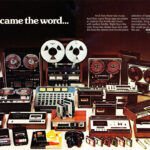Exploring “what is a reel-to-reel for?” reveals a captivating world of audio technology. Reel-to-reel tape recorders are key in recording and playing back sound. They offer a unique experience that many digital formats can’t match.
These machines give a hands-on feel to audio, attracting audiophiles. The warmth and depth of vintage audio equipment like reel-to-reels celebrate analog sound. It’s a sonic experience that honors the art of analog.
As we delve into these devices, it’s clear why they’re cherished in music collections and studios. They hold a special place in the world of sound.
Understanding the Basics of Reel-to-Reel Tape Recorders
Reel-to-reel tape recorders are a unique example of analog audio systems. They capture sound in a special way. The key parts include reels, tape heads, and motors, all working together.
The reels hold the tape, and the tape heads turn sound waves into magnetic signals. This lets audio be recorded and played back well.
To get the reel-to-reel basics, you need to know how sound is captured. Sound waves are magnetically imprinted on the tape, making a lasting audio copy. The type of tape used is very important; it affects the sound quality.
Knowing about different tape types helps you appreciate their role in sound quality. Understanding these basics can make your experience with reel-to-reel systems better.
The History of Reel-to-Reel Audio Technology
The journey of reel-to-reel audio technology began in the 1920s with the discovery of magnetic tape. This was a major leap forward in audio technology evolution. Pioneers set the stage for reel-to-reel recorders to grow. By the 1940s and 1950s, names like Studer, Ampex, and TEAC became top names in making these vintage recording devices.
These companies were key in creating high-quality sound recording methods. Reel-to-reel machines became favorites among both professionals and hobbyists. Their durable build and clear sound changed how music was recorded, affecting both studio and home recordings. As more artists used this tech, the unique sound of reel-to-reel became a key part of music.
Reel-to-reel systems became widely used, showing their big impact on recording sound. They opened the door to the modern sound technology era.
What is a Reel-to-Reel for: Uses and Benefits
Reel-to-reel tape recorders have many uses that show their benefits. They offer top-notch sound quality and keep audio safe. Knowing these points helps us see their value in both work and personal recording.
Enhanced Sound Quality
The reel-to-reel benefits include amazing sound quality. Analog recording gives a warmth and richness that many love. It captures a wider range of sound than digital formats, making music feel alive.
Audiophiles love this quality because it makes recordings feel real. It’s hard to find this in digital formats.
Preservation of Audio
Reel-to-reel technology is great for keeping audio safe. Tapes can keep sound quality for decades. This makes reel-to-reel perfect for saving historical recordings.
Archivists choose reel-to-reel for its ability to last. It’s a reliable way to keep important soundtracks safe for the future.
Reel-to-Reel vs. Other Audio Formats
The world of audio formats is always changing. Reel-to-reel tape recorders stand out for their special qualities. They differ from vinyl records and digital audio in many ways.
Each format has its own charm, fitting different tastes and uses. The main differences lie in sound quality, ease of use, and how people use them.
Comparing with Vinyl Records
The debate between vinyl and tape is popular among music lovers. Vinyl records have a warm sound that many enjoy. This sound brings back memories, making listening a special experience.
Reel-to-reel, however, can record longer songs with better sound quality. It can handle different recording speeds, offering a wider range of sound. This makes reel-to-reel clearer and more detailed than vinyl.
Digital Audio vs. Analog Sound
Digital audio is convenient, offering easy access to many songs. But some say it lacks the warmth of analog recordings. Reel-to-reel machines offer the best of both worlds.
They capture the real sound of analog while allowing longer recordings than vinyl. This meets the needs of those who love the depth of analog and the ease of digital formats.

Choosing the Right Reel-to-Reel Machine
Finding the perfect reel-to-reel machine is a big decision. You need to think about several important features. These include tape width, speed options, and audio channels. Each one affects the sound quality and how easy it is to use.
Key Features to Look For
Start by looking at the tape width. Wider tapes usually sound better. Then, check the speed options, known as tracks per inch. This can change how well you record and play back your music.
Also, think about whether you want mono or stereo audio channels. This depends on how you plan to use the machine.
The build quality is also key. A well-made machine lasts longer and sounds better. Look for brands like Studer and Otari. They offer good options for beginners and pros alike. Reading user reviews can help you make the right choice for your needs.
How to Maintain Your Reel-to-Reel Equipment
Keeping your reel-to-reel equipment in good shape is key. Cleaning the tape heads regularly is a must. Dust and dirt can ruin sound quality over time. Make cleaning a part of your routine to avoid this.
It’s also important to demagnetize the tape path. Magnetic buildup can mess with playback and recording. A demagnetizer keeps your audio signal strong and your equipment lasting longer.

Where you store your equipment matters a lot. The right temperature and humidity levels are crucial. Too much moisture can warp tapes or cause mold, while dry air can make them brittle. Choose a good storage option to protect your gear.
For tape care tips, always handle tapes with clean hands. Store them upright to prevent warping. Also, keep them away from direct sunlight and extreme temperatures. These steps help keep your audio equipment in top condition.
The Importance of Reel-to-Reel in Modern Audio Production
Reel-to-reel technology is making a comeback in music studios. It brings a unique warmth and authenticity to music. Artists and producers love it for its hands-on feel, which boosts creativity.
This trend shows a growing need for music that feels real and engaging. It’s about capturing a sound that’s organic and connects with listeners.
Impact on Recording Techniques
Reel-to-reel has changed how we record music. It allows for rich, detailed sounds that many want. Engineers can play with tape speed and use special recording tricks.
Recording on tape means accepting small mistakes. This makes the music more relatable and human. In a world of perfect digital sound, these imperfections add character.
Community and Culture Surrounding Reel-to-Reel
The reel-to-reel community is full of life and passion. People who love analog sound come together. They share tips and stories on forums and social media.
These gatherings make everyone feel connected. They love the feel of reel-to-reel tapes, unlike digital sounds. It’s a special experience.
Events like conventions and swap meets are key. They help keep the love for analog sound alive. At these events, people meet, share, and even trade equipment.
Many enjoy fixing old machines or finding rare tapes. It makes their love for vintage audio even stronger. The energy at these gatherings is amazing.
The reel-to-reel culture is more than just old memories. It’s about loving quality sound and craftsmanship. People in this community celebrate audio history and keep it alive for others.
As the culture grows, so does the passion. It shows how much people love analog recording. It’s a timeless tradition.












